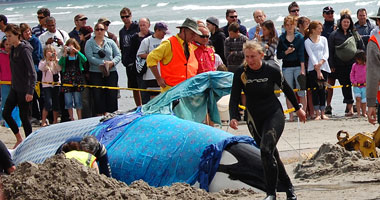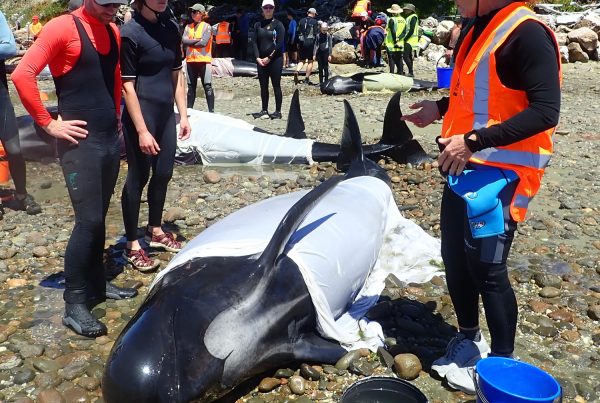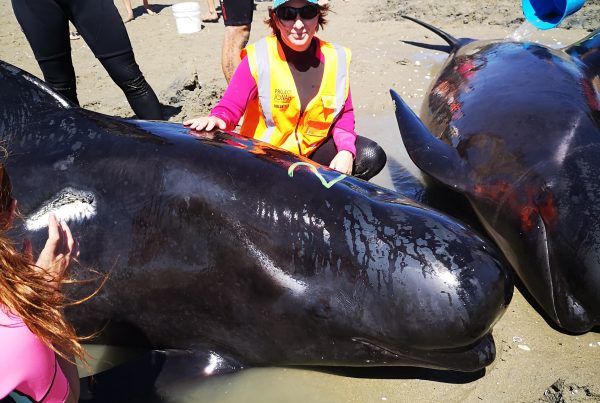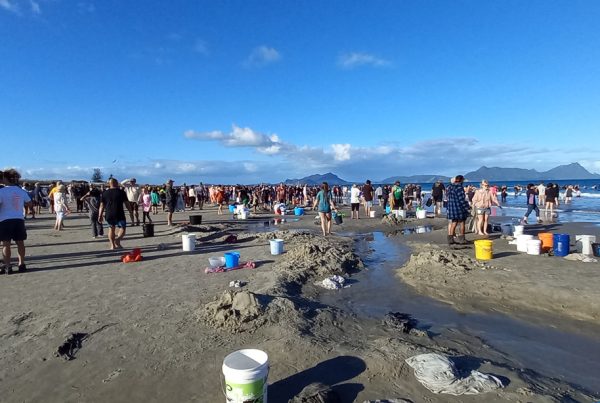
27 September 2008
The message was received 7am on Saturday morning – ‘Whale stranding BOP area, text back YES if you can attend’. Was this someone having a laugh or the real deal? I messaged back YES and put down my phone thinking that someone would reply that the joke was on me, how wrong I was.
Nobby, a 30 year old orca male, had stranded himself on Papamoa beach in the early hours of Saturday, 27th of September. We were to discover later in the day that this was not Nobby’s first time on the beach, however this time he needed some help. I received my next text around 11am requesting urgent attendance to Papamoa beach, this was really happening and I had to think quickly as to what it was that my training from Project Jonah advised me to pack in my emergency stranding bag. Ready to go after a quick double check that I had everything (wetsuit, check – towels, check – warm clothes, check – car keys???) myself and my partner were on the road.
We arrived at the beach where cars crammed the streets and beach access ways. News had travelled fast and was drawing curious locals by the hundreds. We made our way to where Nobby was and I could not believe what I saw. Having just completed my training with Project Jonah earlier this year I was in the frame of mind that it would be years before I was ever called to take part in such an event. But here I was witnessing the massive impact that this single whale was having on the surrounding crowd. I pushed my way through the masses and yelled out that I was part of Project Jonah to one of the helpers on the other side of the tape. They waved me through and this was when I caught my first glimpse of Nobby.
It was surreal and I don’t remember thinking ‘Oh, there’s an orca whale on the beach’ that connection was made later on, but I did go up to the first person that I saw controlling the crowd from getting too close and asked them to point out PJ, the person who had sent me the text messages and who I had to report to. It only dawned on me after the rescue that PJ was actually short for Project Jonah.
I noticed familiar faces of people that I did Project Jonah training with and who were also classmates from where I was studying at the Bay of Plenty Polytech in Marine Studies. This relaxed me and for the first time I actually took in what was before me.
Nobby had been out of the water for eight hours when I first arrived but the tide was moving in at a steady pace and a deep channel that was dug out with a digger was helping to move water in faster. The PJ members were called together and briefed about what our job was and how to execute it effectively and with minimal impact on Nobby. We were to support Nobby as the tide moved in and help keep him stable while he re-balanced himself from being on his side all day. It was important to not hold Nobby but to simply lean against him and act as a type of buffer all the while making sure that we were not in any danger. Slowly we would make our way out to sea while still supporting Nobby and then when the time was right and the water deep enough, allow Nobby to swim back out to sea.
The tireless efforts of the local surf lifeguards was amazing, back and forth with buckets of water to keep Nobby cool and also building a sand bank to ensure that Nobby was stabilised as best as possible while out of the water. It was now our turn to get in the water with Nobby and give him that final ‘push’ of support.
My main job was to give those holding Nobby enough warning of large waves approaching. As Nobby was initially lying along the beach the waves were tipping him over constantly and also pushing those that were stabilising him into his body. Over a short period of time we managed to have Nobby turned and facing out to sea. This was a pinnacle point as now Nobby could start making sense of where he was by using his echo-location and would hopefully give him drive to get back out to sea.
The Department of Conservation and Dr Ingrid Visser were leading the rescue mission and had us all focused on the task at hand. With one goal in mind we slowly moved Nobby further out.
The waves were coming in steady now and slowly increasing with height. This was good as each wave gave more depth and motion for Nobby to work with. More and more Nobby moved and pushed with his body. More helpers were called in to create a a barrier either side of Nobby to encourage him to go straight out instead of turning back into land. This was when I could suddenly hear the crowd. Children were chanting ‘Go Nobby, Go’ and people were cheering and clapping their hands every time Nobby made progress out.
A sensation of smiles started moving through all of us that were in the water with Nobby, he was moving now. Those that were supporting his body quickly moved away from him as his tail started thrashing on the surface. He was giving it his all, slowly moving back out to deeper waters, as he got further and further his tail flicks deepened and slowed down. Like a car gaining traction Nobby was moving out! We all stood and watched then suddenly started jumping up and down punching the air with our fists, smiles erupting onto our faces and yelling after Nobby to ‘Go for it!’. What a score of emotions that pass through me at that moment. The relief that he has made it, the fear that he may turn straight around and come back into land once again, the exhilaration of having been so close to such a creature, the physical drain of what I had just done, these all passed through me and it wasn’t just the salt water that was causing my eyes to leak a bit.
I turned back to land and for the first time realised how many people had come to see this wonderful orca whale. The dunes and beach were lined with cheering people and this only added to the whole experience. To know that so many people cared and supported what we had done and that all this effort was worthwhile was immense. Still grinning I made my way back to the beach to be de-briefed.
My training with Project Jonah has already given me a life-time experience. My partner and friends having witnessed what happened on Saturday are now all keen to do the course also. We were lucky in the fact that this was a single stranding, had it been a multiple stranding it would have been harder and potentially more dangerous as you rely on people who have the best intentions but not the knowledge on how to keep themselves safe and the whale calm. The more people that complete the course the better. Knowledge and understanding are the best tools in rescuing our precious marine mammals and is something that will give you ever lasting memories.


